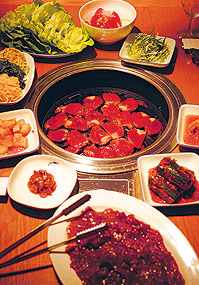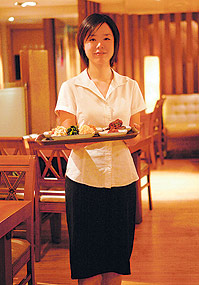Jan Moir Are You Ready To Order
Shortly after we arrive at Asadal, a new Korean restaurant next door to Holborn tube station in central London, S asks our lovely waitress, Suji, what her favourite dish is on the menu, and would she please bring it forthwith, whatsoever it might be? Shortly afterwards, a mighty bowl of ojing uh kan poong gi appears, a pyramid of soft curls of fresh, tender squid, flash-fried and then tossed in a haunting, spicy sauce that's both hot and sour and completely compelling. It would be nice to save room for the super-healthy stuff to come but oo-we, we are powerless to resist.
 ''I love this so much I wish I had two stomachs,'' says Suji and I think, well, stick with me, girlie, and I'll show you how easy it is to grow one really big one. ''I love this so much I wish I had two stomachs,'' says Suji and I think, well, stick with me, girlie, and I'll show you how easy it is to grow one really big one.
Korean food is so incredibly healthy, so virtuously, righteously good for you that it's amazing it's not as popular as Pilates, juicing, cupping or wearing a red string around your wrist to show that you really, really love Madonna's new lace-up boots. It has both ancient Chinese and modern Japanese influences, but a fondness for chillies and pickles and a boldness of flavour that are entirely its own. Harmony of taste is important, as is the oriental rule of five flavours: salt, sweet, sour, hot and bitter. To this list perhaps we must add umami, the planet Pluto of the taste world, which was only recently discovered and named, although it's been there in the background all along.
Umami accounts for the taste sensation found in glutamates, and its presence is announced by a deep, ticklishly savoury hit. It's there, for example, in kimchi, the dish of fermented vegetables - usually cabbage - and chillies that is at the heart of Korean cooking and served at almost every meal. Kimchi might not sound very pleasant but it is; almost like pungent sauerkraut, very moreish and refreshing.
Other definitive Korean dishes include bulgogi (sesame steak), bibimbab (rice topped with vegetables, beef and a fried egg), japchae (cellophane noodles with beef and vegetables) and geon bok hwae, which is freshly sliced abalone and regarded as something of a treat. Most dishes are mixed together just before eating, sharing is important and it is usual for everything to be brought to the table at once and eaten with metal chopsticks. So there you go. My potted guide hardly does justice to thousands of years of evolving Korean culinary history, but at least S seems to have grasped what's going on.
''There's a lot of barbecue, right?'' he says, peering into the circular gas barbecue pit sunk into the middle of our table. Suji nods as she fires it up, drops a perforated dome over the flame and goes off to fetch the dishes of marinated meats we will cook there. In the meantime, there's lots of good stuff to try.
 Dol sot yuk hei bibimbab is a large, ferociously hot stone bowl brought to the table with little piles of raw ingredients arranged like a clock face on a cooked rice base. As you gently stir and mix the ingredients - strips of carrot, bean shoots, onions, cabbage and spicy raw beef - the heat of the bowl cooks them. The dish is usually served at lunchtime on its own, or perhaps even for breakfast, which is the main meal of the day in Korea, and is more than enough for a nutritious, satisfying meal. Dol sot yuk hei bibimbab is a large, ferociously hot stone bowl brought to the table with little piles of raw ingredients arranged like a clock face on a cooked rice base. As you gently stir and mix the ingredients - strips of carrot, bean shoots, onions, cabbage and spicy raw beef - the heat of the bowl cooks them. The dish is usually served at lunchtime on its own, or perhaps even for breakfast, which is the main meal of the day in Korea, and is more than enough for a nutritious, satisfying meal.
A kimchi set produces three types of spicy, pickled vegetables - cabbage, white radish and cucumber - which provide an excellent source of the vitamins, enzymes and minerals necessary for a healthy digestive system. However, Gae jang was a step too far down the path of authenticity for me. It's an impenetrable pile of unshelled, chopped raw crab varnished with a thick gloss of slippery chilli sauce, served ice cold. It's like eating fridge spill.
''I did warn you,'' says Suji as she throws marinated strips of beef on to the barbecue, then snips them into bite-sized pieces with a pair of scissors. As with the spicy chicken version that follows, you eat it by holding a leaf of lettuce in the palm of your hand, adding some rice, a piece of barbecued meat that you have trailed in a vinegar-based dip, a dab of soya bean paste and a few slivers of marinated spring onion before rolling it all up and eating it in one go. It's completely delicious - a healthy, low-cal and vastly superior version of a duck pancake.
Asadal is low key and elegant, a basement restaurant that provides both a haven in this hectic part of town and a jolly night out in its own right. It is atmospheric in the evenings, when staff will help out with the barbecue tables, which have a help button on the side if you need to summon assistance.
Wine isn't important, although there is a gold medal Gewürztraminer from Alsace for £19.50 on the short list that goes with everything, should you be minded. Each meal ends with a cup of chilled cinnamon ginger tea, garnished with toasted pine nuts and a deep feeling of wellbeing. I'd go back just for the squid, but he came home with me anyway.
- Asadal Korean Restaurant, 227 High Holborn, London WC1 (020 7430 9006). Dinner for two, excluding drinks and service, £60.
|


Bookmark this article with: